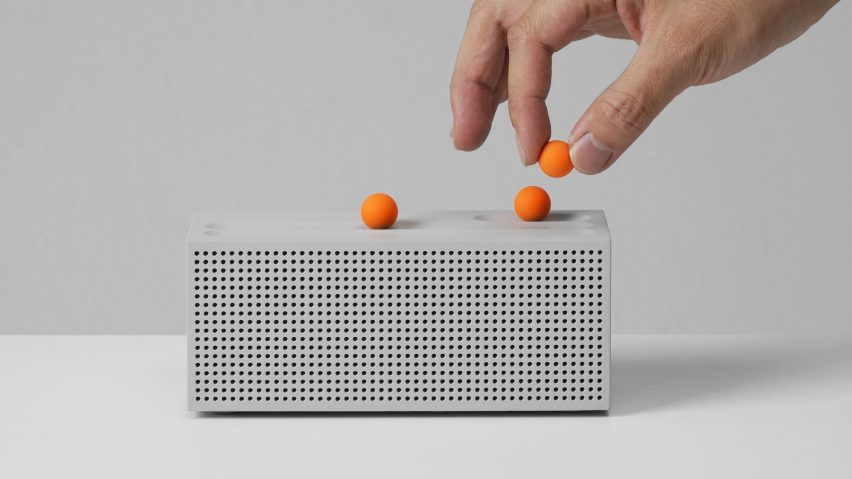Industrial design duo SF-SO forgo homogenous touchscreens in favour of a sensory, analogue interface for products that offer users a respite from their online lives.
The Tamed Digital Product Project has four parts – a smart door lock, a bluetooth speaker that can be switched on simply by being turned on its side, and two different radios.
Rather than adding endless functions to create multi-purpose high-tech devices, SF-SO instead reduced each item down to its core function.
"Sometimes a radio is also used as an alarm or a clock," SF-SO's co-founder Jaehoon Jung told Dezeen.
"But we wanted to go back to the product's original function and core interaction which has been used by people for decades."
Each has a grey, geometric body, with single elements like buttons and handles coloured in eye-catching shades of highlighter orange and green to create an intuitive understanding of its basic function.
"We used pops of colour to emphasise the main features," said Jung. "The colour contrast naturally allows users to recognise that element to be a core function."
The Wheel Digital Radio pays homage to its analogue forebears – which were tuned by the twist of a button.
It turns the idea on its head by having the whole product act as one giant dial that is rotated like an egg timer around a neon green needle to find the desired station.
With a shape reminiscent of a megaphone, the Cone Bluetooth Speaker on the other hand can be powered on and off intuitively by flipping the speaker using its brightly-coloured handle.
"The device uses gravity sensor technology to detect whether the device is standing upright or lying down – the same one your smartphone uses to rotate the screen automatically," Jung explained.
While the smart door-lock looks like the classic turn and release lock you might find in a bathroom, it also features a fingerprint scanner integrated into the side of the handle to enable it to be unlocked and opened within one and the same gesture.
Beyond simplicity, another major focus was the tactile pleasure derived from interacting with a physical product as opposed to a sleek touch-screen.
That's why the Ball Internet Radio integrates an element of play using the bright orange buttons that rest in grooves along the top.
"The balls are magnetic, and when they are placed on the numbers that make up each radio station, they are detected by other magnetic sensor inside of the radio," the designer explained.
"The sensor connects to specific digital radio stations and automatically pairs with the user's mobile application."
As a final step, the otherwise shiny, plastic shell of each products was also sand blasted to create a satisfyingly smooth, matte finish.
Through this simplified design, the studio hopes to eliminate the hassle of keeping up with ever-more technologically advanced products.
"So many new technologies have been developed for people's convenience, but ironically they actually just give them even more things to do," Jung explained.
"They have to spend time and effort learning the latest features built into their products."
SF-SO is a studio based between San Francisco and Seoul, that was founded by Jung and fellow design director Hoyoung Joo.
Among the duo's other projects is the H-beam lamp series, which sees the archetypal construction material used as a basis for three different lights.
Elsewhere, researchers at the MIT media lab have turned plants into living motion sensors and displays, in the hopes of offering a more wholesome alternative to electronic screens.

